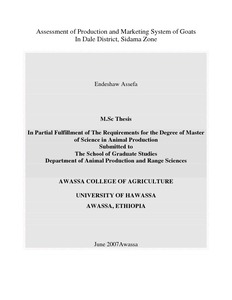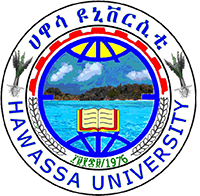Resource information
Production system and marketing study was undertaken using on 120 sample households to identify and describing goat production systems, to determine production potentials, opportunities and challenges of goat’s production and to describe marketing systems. Three The households were drawn from different location and represented three agro-ecologies; Moist Weyina Dega, Dega and Moist Kola. Sampled households were interviewed on socio economic characteristics, flock structure, reproductive performances of goats, feed resources and feeding, routine husbandry management systems and marketing using a pre-tested formal questionnaire. Flock monitoring to identify off take and acquisitions like birth, purchase, transfer and disposal like sales, slaughter, death was carried out for about seven months (September to March). Three primary, one secondary and one terminal markets were studied at Dale, Tula and Hawasa, respectively using Rapid Marketing Appraisal (RMA) technique. The average family size was 7.5± . 247 per household, out of which 5.6% of the households were females and there was no significant difference (p<0.05) in family size among the three-agro ecologies. About 75 % of interviewed male households and 50% female households were literate. The overall mean livestock holdings was 13.1 ±1.16. Among the three-agro ecologies, the average livestock holdings in Moist Kola was significantly higher than in Moist Weyina Dega and Dega. The overall mean goat holdings per household was 5.98 and there is a wider range of variations in flock sizes in agro-ecologies??. The overall mean AWA, AFM, AFK, AKI, was 5.2, 9.7, 14.9, 8.6 and 16 months, respectively. Overall mean litter size was 2.07 and lifetime kidding age (parity) was 13.2 months. AWA in Moist Dega was 6.47± 45 , and was significantly longer (p<0.05) than in Moist Weyina Dega and Moist Kola. Similarly, the average AFM was 16.13 months in Moist Dega, and was significantly longer (P<0.05) than in Moist Kola but. Moist Weyina Dega was intermediate of the two-agro ecologies. AKI was 8.56, 7.27 and 8.57 months in Moist Dega, Moist Weyina Dega and Moist Kola, respectively and varied significant (P<0.05) among the three agro ecologies. Mean LS for Moist Kola and Moist Weyina Dega was significantly(p<0.05) lower than that of Moist Dega. Goats in Moist Kola have shown long lifetime kidding or parity (P) of 16.27 years, which is significantly longer (P<0.05) than that of the other two agroecologies. Feed resources for goats varied among agro ecologies. Shrubs and trees are the major feed sources for free foraging goats in the Moist Kola but, feeds from crop by products, crop residues, enset and fruit parts, vegetables and chat leftovers are the main feed sources for tethered and herded goats of Moist Weyina Dega and Dega. Lack of feed, diseases and marketing are the major constraints affecting goat’s production. The increasing demand for goat meat, the awareness of rural goat herder about the current price and willingness and attempt to carry out small scale goat fattening activities to utilize the current goat market, the conduciveness of the environment and sufficient man power in the three agro ecologies are the encouraging opportunities to improve goats production and marketing.



